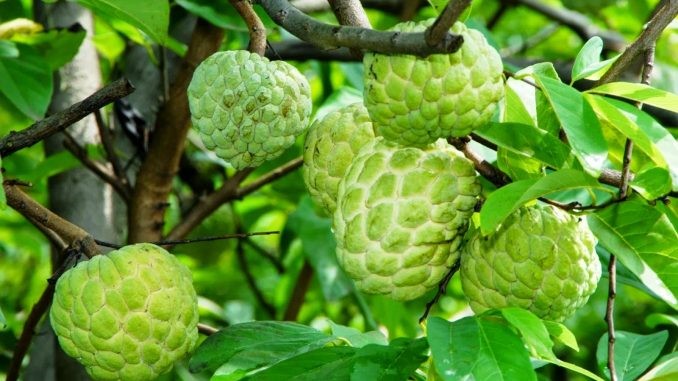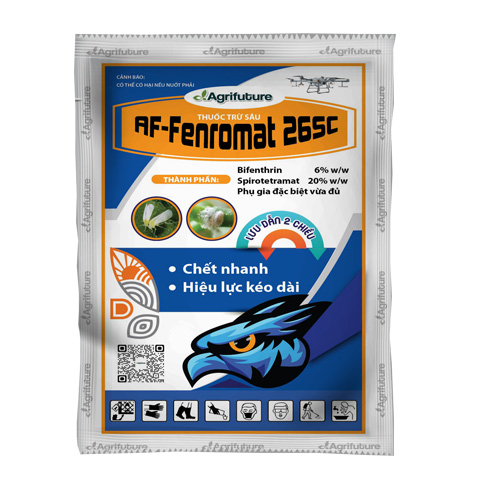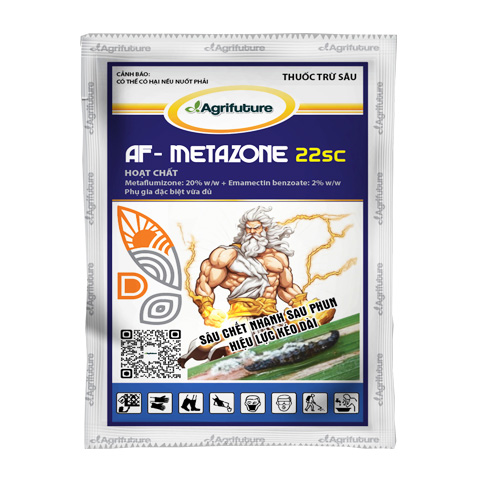The sugar apple (Annona) is a species belonging to the Annona genus, originating from the tropical Americas. It is a fairly popular and highly favored fruit tree. Recently, this fruit has become a potential commodity, bringing high economic value to the people. Join Agrifuture to explore the cultivation techniques and common pest prevention methods for the sugar apple tree in the following article.

To achieve high productivity in cultivating a garden of custard apple, it is essential to ensure the supply of diverse nutrients to the plants. Additionally, understanding the manifestations, causes, and treatment methods of various pests and diseases is crucial for timely intervention and safeguarding the health of the plants.
1.White Wax Scale
a) Damaging Characteristics
White wax scale pests primarily affect the leaves and fruits of the custard apple tree. Their bodies are covered in a white, powdery wax. These pests concentrate on sucking sap from the leaves and fruits, causing leaf curling and inhibiting fruit growth. If they attack during the early fruiting stage, the fruits tend to fall prematurely. When infestation occurs during the mature fruiting stage, the affected fruits lose their commercial value. The excretions of white wax scale provide favorable conditions for the growth of sooty mold, which further diminishes plant vigor. White wax scale infestations persist throughout the year in custard apple orchards, causing significant damage, particularly during sunny seasons.
b) Control Measures
• Product Information: AF - Fenromat 26SC:

Characteristics and Uses: AF - Fenromat 26SC is formulated from a unique combination of two advanced active ingredients with two powerful insecticide mechanisms, acting directly on the peripheral nervous system and inhibiting ACC, thereby disrupting the lipid synthesis process in insects. Hence, the pesticide is instantly effective even against resistant pests and remains efficacious for several days after application.
Usage Instructions: AF - Fenromat 26SC is registered for the control of pod borers on peanuts.
Dosage: 500ml/ha. Dilute 20ml in a 25-liter water tank.
Water Volume: 450 - 500 liters/ha.
Timing: Apply when the borers first appear (1 - 2 weeks old). Density: approximately 1 - 2 borers/plant.
Re-entry Interval: 14 days.
2.Fruit Borers
a) Harmful Characteristics:
During the adult stage, the moth is grayish-brown, with forewings exhibiting a metallic green color. The larvae are black, and when fully grown, measure about 20 - 22mm in length. Newly hatched larvae begin to bore into the fruit flesh. Symptoms include visible larvae excrement outside the fruit. Typically, a single fruit can harbor multiple damaging larvae.
b) Control Measures:
Regularly inspect orchards to detect larvae promptly. Remove infested fruits from the orchard. Agrifuture recommends using Af - Metazone 22SC to effectively control fruit borers in peanuts.
• Product Information for Af - Metazone 22SC: (Information not provided

Characteristics and Uses: Af-Metazone 22SC: A new generation product with the ability to effectively eliminate most types of pesticide-resistant pests through a specialized mechanism. The pesticide inhibits muscle contraction, causing a continuous influx to specific GABA and H-Glutamate receptor sites. Additionally, it blocks sodium channels by selectively binding to slow-inactivated states. Therefore, Af-Metazone 22SC is fundamentally different and superior compared to similar products.
Instructions for use: Af-Metazone 22SC is registered for the control of borers on peanut crops.
Dosage: 0.5 liters per hectare. Dilute 20ml in a 25-liter tank of water. Water volume should be 500 liters per hectare.
Apply when pests are newly emerged (1-2 weeks old). Density should be around 1-2 pests per plant.
Re-entry interval is 7 days.
3.Elephant weevil
a) Harmful characteristics
The adult elephant weevil is a species of hard-shelled beetle with a glossy brown color, elongated head protruding forward resembling a trunk, and chewing mouthparts at the end of the trunk. The female lays eggs in the punctures on flower stems. Both the adult and larvae feed on and damage flower stems. They attack newly bloomed flowers, causing them to turn black and dry out, with dried flowers remaining stuck on the plant.
b) Control measures
Because elephant weevils often hide within flower stems, conventional insecticides are less effective against them. It is necessary to use insecticides with strong fumigant properties to repel adults and eliminate larvae. Agrifuture company recommends using effective preventive and control products such as AF - Fenromat 26SC to quickly eradicate elephant weevils on banana plants.
• Information on the product AF - Fenromat 26SC:

Characteristics and Uses: AF - Fenromat 26SC is formulated from a unique combination of 2 advanced active ingredients with 2 separate powerful insecticidal mechanisms. The pesticide directly affects the peripheral nervous system and inhibits ACC, disrupting the lipid synthesis process in insects. Therefore, the pesticide is effective immediately, even against resistant insects, and its efficacy lasts for several days after application.
Usage Instructions: AF - Fenromat 26SC is registered for controlling fruit borer on peanuts.
Dosage: 500ml/ha. Mix 20ml with a 25-liter water container.
Water volume: 450 - 500 liters/ha.
Timing: Spray when the borers first appear (1 - 2 weeks old). Density of about 1 - 2 borers per plant.
Re-entry interval: 14 days.
If you notice any of the mentioned signs in your banana plantation and require assistance on how to handle it, please leave your information! The Agrifuture team will promptly get in touch to support you.
Wishing you a fruitful and high-quality orchard with economic efficiency!